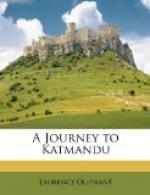Jung alone looked for no expressions of surprise or admiration from us, but was evidently disappointed and chagrined at the inferiority of his own soldiers to those he had seen in Europe and amongst our Indian troops. He could indeed point with pride to the stalwart bearing and soldier-like appearance of his men, but he had seen “the Guards” reviewed, he had been present at an inspection of 15,000 of the French army at Versailles, and he seemed half ashamed of the display we were witnessing, notwithstanding our efforts to comfort him by telling him that we had little thought the art of war was so far advanced in the wild valleys and rocky mountains of Nepaul.
CHAPTER XIII.
Distinguishing features of the races of Nepaul—The Ghorkas—Conquest by them of Katmandu—Maintenance of the Nepaul army—Bheem Singh’s monument—A feast at the minister’s—We bid him adieu—Ascent of the Sheopoori—Magnificent view of the Himalayas from its summit.
The grand review over, we availed ourselves of the opportunity to inspect the regiments composed of men recruited in some of the most distant provinces of Nepaul. They bore in their countenances little resemblance either to the Ghorkas or Newars. We examined their faces, and tried to imagine what sort of a looking country was likely to produce this sort of a looking man. A regiment of dark-visaged stalwart Ghorkas would march past, followed by a diminutive race from the north-western frontier, little, ill-made, and abominably ugly. The same cast of countenance was prevalent throughout the regiments that had been recruited there; all the men had the same high cheek-bones, or wide mouths, or whatever their peculiarity might be. The insignificant Newars looked majestic by the side of these men, while in their turn their own strong Chinese characteristics were thrown completely into the shade by some regiment from the north-east, almost pure Bootyan or Mongolian.
There are not, however, many Newars employed as soldiers, and the army is chiefly composed of Muggurs, Gurungs, and Krats. These tribes differ only in their religion, according as it combines in a greater or less degree the superstitions of the Hindoo worship with those of Bhuddism. But none of these races differed from one another more completely than did the Ghorka from them all; he was the only man among them born to be a soldier, and he looked with contempt upon the mongrel races that surrounded him.
The country from which he himself originally sprang is nevertheless a matter of speculation; he certainly is not of trans-Himalayan origin, but no doubt the comfortable life he leads in Nepaul prevents his caring to inquire whence he came. The Rajah claims descent from the Rajput princes. The capital town of the country from which they descended into the valley of Nepaul is Ghorka, situated about fifty miles westward of Katmandu. The Ghorkas had already possessed themselves of the whole territory to the westward for some hundred of miles until their border touched the kingdom of Runjeit Singh and the vale of Cashmere; they then turned their conquering arms eastward in 1716, and, overrunning the valleys of the Newars, their progress was only arrested on the Sikkim frontier.




